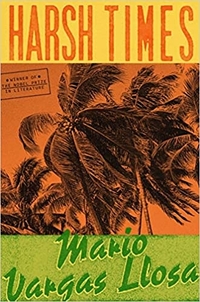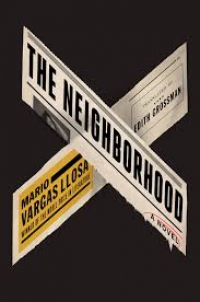Harsh Times by Mario Vargas Llosa
 Monday, November 22, 2021 at 5:55AM
Monday, November 22, 2021 at 5:55AM 
First published in Spain in 2019; published in translation by Farrar, Straus and Giroux on November 23, 2021
Harsh Times is the story of Guatemala in the middle of the twentieth century. The book can’t quite decide whether it wants to a novelized history or a character study. The story is framed by the political actions and personal reactions of several characters, most notably a young woman named Marta Borrero Parra.
Guatemala has a history of “murdered politicians and presidents,” including Carlos Castillo Armas, who governed from 1954 to 1957 and, as Mario Vargas Llosa tells it, took Marta as a lover after she left the friend of her father who made her pregnant in her early teens. Marta weaves in and out of the narrative in the novel’s first half before she disappears for a long while, leaving the story to be framed by a succession of other characters, most of whom serve in government or the military. None of those characters are as compelling as Marta, whose vulnerability as an outsider gives her a unique role in a story about powerful men who abuse their power. Marta’s reappearance in an epilogue adds a few details about her life but does little to wrap up the story, given the conspiracy tale she spins about a character who (like Marta) left Guatemala and reinvented himself. Perhaps Llosa’s point is that separating truth from fiction is a daunting task when some conspiracies are real and others are imagined.
Instead of focusing the novel on central characters, Llosa chose to focus on historical events in Guatemala and other Central American or Caribbean countries. Armas took power in a military coup orchestrated by the CIA with a mandate to root out real and imagined communists, defined as anyone who believed workers should organize, elections should be fair, and power should not be concentrated in the hands of the corrupt.
Llosa spotlights the American anti-communist crusade of the 1950s as the instrumental force in Guatemala’s development. In Llosa’s version of history, the crusade was manipulated by a Machiavellian public relations consultant for United Fruit, a banana grower that oppressed workers and ruthlessly acquired land in Guatemala. United Fruit sought public relations assistance because it wanted to reform its cutthroat image without losing its power. Telling the blatant lies that the PR guru concocted, United Fruit claimed to be the victim of a communist government, although none of its productive land had been nationalized and it was the only grower in Guatemala that didn’t pay taxes. According to Llosa, the pro-democracy government that preceded Armas was simply trying to move away from a feudal society by using eminent domain to redistribute unproductive land to peasants who would put it to good use, a win-win for the peasants and for Guatemalan society. United Fruit thought it was only a matter of time before democracy would result in a government it couldn’t control; hence the deceptive PR campaign.
Nothing serves a public image better than championing anti-communism, even if United Fruit’s true aim (shared by the American government) was to undermine Guatemala’s emerging democracy and quash its efforts to distribute power and wealth more equitably. After the CIA orchestrated the government’s overthrow, Armas nullified deeds to small plots of land that pulled Guatemalans out of poverty and imprisoned or killed union organizers and dissenters. But America wants a democratic façade in its banana republics and Armas, having carried out the country’s shift to the far right with murderous zeal, didn’t even pretend to be interested in democracy. Thus the CIA’s support for the assassination of Guatemala’s president three years after it brought that president to power. A fickle agency, the CIA.
Whether the story’s political background is accurate in all of its particulars doesn’t matter. This is a work of fiction, after all, and while the political narrative is interesting, characters drive literary novels. The narrative weaves back and forth in time, focusing on various players at different times: Dr. Efrén García Ardiles, the friend of Marta’s father who raped Marta and made her pregnant while she was a young teen before marrying her at her father’s insistence (a marriage that allowed Marta’s father to disown her); Jacobo Árbenz Guzmán, the alcoholic but well-intentioned defense minister who became the pro-democracy president of Guatemala until the CIA intervened; Enrique Trinidad Oliva, Armas’ director of security whose life rises and falls in ways that parallel Guatemalan governments; Mike Laporta, a CIA agent who “couldn’t look more gringo if he tried”; American Ambassador Peurifoy, a willing pawn of Allen Dulles and the CIA; Rafael Trujillo, the ruthless dictator of the Dominican Republic; and Johnny Abbes Garcia, the anti-democratic chief of Dominican intelligence under President Trujillo whose life took unexpected turns after Trujillo was killed.
Marta is the most sympathetic of this large cast of characters, if only because she is so often used and condemned by men. Her shift to the far right when she becomes a radio commentator is an act of self-preservation, as was bedding Armas. Her decision to abandon her child to be raised by her rapist is understandable, as are the choices she makes to survive in a world where men see only a potential conquest when they gaze in her direction.
I’m not sure that the novel’s shifting time frame serves a purpose, other than to remind the reader that this is a novel and not a history text. Still, some chapters read like a lively history text, contributing little but a perspective on history to the story. Llosa introduces a central character to serve as a focal point for those chapters, but those characters tend to appear for a brief time and disappear after they have served their purpose, giving those chapters a disjointed feeling. A cadet named Crispin Carrasquilla, for example, is featured in a late chapter that tells of a clash between military cadets and invading forces. A diplomatic agreement (soon to be violated) resolves their conflict, a small episode that (Llosa assures us) “would hardly appear in the press or the history books.” Crispin’s chapter contributes little to the overall narrative.
The novel’s struggle between its focus on history and its attempt to be a character study causes Llosa to follow characters like Abbes Garcia after he eventually lands in Haiti. While the gruesome end of Garcia’s story would merit its own book, it seems disconnected in a novel that wants to tell a story of Guatemala.
As a broader history, although driven by a mix of invented and real characters, Llosa reminds the reader of important geopolitical realities. Every attempt the US has made to meddle in the internal affairs of governments it perceives as “leftist” has backfired. Llosa argues that Cuba moved in the direction of communism and dictatorship as a direct result of the CIA’s interference with democracy in Guatemala. “When all is said and done,” Llosa writes, “the North American invasion of Guatemala held up the country’s democratization for decades at the cost of thousands of lives, as it helped popularize the myth of armed struggle and socialism throughout Latin America.” Just as salient is Llosa’s illustration of how easily the American public is manipulated by corporate interests that invent fears of communism to conceal the harm their business practices inflict on ordinary people. While Harsh Times might be more effective as a history lesson than a character-driven novel, it is never less than engrossing.
RECOMMENDED
